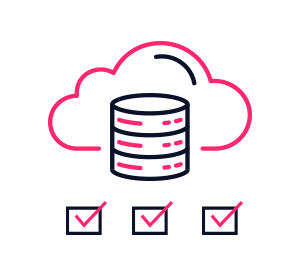As businesses continue to migrate their workloads to the cloud, selecting the right managed database solution becomes crucial. Microsoft SQL Server, a backbone for many organizations, requires careful consideration when choosing between different cloud offerings. In this post, we’ll compare managed SQL Server solutions available on Silk, Microsoft Azure, Amazon Web Services (AWS), and Google Cloud, focusing on their architectural workload requirements, database engine capabilities, resiliency, operational models, and innovation ecosystems.
Let’s dive in and explore the options available to ensure your SQL Server workloads are managed efficiently, cost-effectively, and reliably.
Managed SQL Server Solutions
We’ll focus on five cloud solutions for managed SQL Server workloads:
- AWS offers RDS for SQL Server.
- Google Cloud provides Cloud SQL for SQL Server.
- Microsoft Azure has Azure SQL Database.
- Microsoft Azure also offers Azure SQL Managed Instance (SQL MI).
- Silk provides the Silk Cloud DBaaS solution.
Technical Workload Requirements
CPU and RAM Options
Each cloud provider offers numerous VM shapes for infrastructure as a service (IaaS), but the choices diminish for cloud database PaaS solutions. For instance, AWS RDS for SQL Server offers a limited selection of VM shapes (4 individual shapes for SQL Server Express and, at most, 70 shapes for Standard edition in US East with even fewer choices in other regions) compared to the broader array available in Amazon EC2 (over 80 families of VM shapes). Similarly, Azure SQL Server has around 120 VM shapes, but Azure SQL MI over offers about 100. Google Cloud SQL has a particularly small number of present instance shapes: 11 at the Enterprise tier and 10 at the Enterprise Plus tier.
In contrast, Silk Cloud DBaaS users can select literally any cloud VM shape that fits their needs, offering a greater range of vCPU to memory ratios and higher compute performance – up to 416 vCPUs.
Capacity
Cloud providers offer some flexibility in provisioning capacity, but their PaaS solutions have limitations. Unlike Silk, they do not support thin provisioning or data reduction, which means paying for storage infrastructure that isn’t actively used. Secondly, they have relatively low maximum capacity, capping out between 4-64 TiB. Silk offers up to 640 TiB of capacity per Silk Data Pod, with essentially unlimited storage possible across multiple pods. Note that this capacity is after thin provisioning, so the full amount of data provisioned can be in the petabytes!
Performance
The performance characteristics of managed SQL Server products vary significantly. AWS RDS for SQL Server offers up to only 64,000 IOPS but excels in throughput at 4 GBps. Google Cloud SQL for SQL Server peaks at 100,000 IOPS and 1.2 GBps, while Azure SQL MI offers up to 320,000 IOPS but with lower throughput. Azure SQL Database has a slightly higher IOPS than Azure SQL MI, but slightly lower throughput.
All of these solutions have a few other notable performance limitations. First, they have high latency that ranges from single to double-digit milliseconds – which is too slow for most important systems. Second, they really don’t offer performance pooling. Azure has instance pools with SQL MI and elastic pools for Azure SQL database, which offers a limited way to pool performance. But with each instance needing its own provisioned performance, it can be difficult to achieve economies of scale.
Meanwhile, Silk leverages the compute network of the cloud instead of the storage network, making it possible to support multiple database host VMs simultaneously. Silk provides up to 2.1 million IOPS or 26 GBps of throughput, all at consistent sub-millisecond latencies.
Growth
Cloud performance limits are tied to VM shapes and slower data networks. As workloads grow, costs for the VM, performance, and database license increase due to the need for larger VM shapes. Silk allows for easy in-place growth, leveraging the scale of Silk’s architecture.
Database Licensing
There are two SQL Server licensing options for cloud PaaS solutions: included licensing and Bring Your Own License (BYOL). AWS RDS for SQL Server and Google Cloud SQL both offer included licensing only. Azure supports both included licensing and BYOL as well as a Hybrid Benefit that allows customers to bring their existing SQL Server licenses. Silk also supports BYOL, making it easier to move existing workloads without breaking existing contracts. If you are building completely new systems, you might be able to leverage the included license solutions by Azure, AWS, or Google.
Which Solution Offers the Best Technical Requirements for You?
Small workloads that are under 8 vCPUs are often a good fit for the hyperscalers’ SQL Server PaaS solutions. At that scale, the cost they charge for PaaS over IaaS is not as impactful as it would be with higher performance systems. Similarly, workloads that run on generic shapes and are unlikely to grow might also fit on AWS, Azure, or Google’s PaaS products. Azure, in particular, is likely a good fit for low performance ephemeral databases with its serverless solution. Medium to large databases that run business-critical applications, however, will run better on Silk with its greater flexibility and scale of VM shapes.
Database Engine Workload Requirements
Along with the technical requirements of the workload, you need to think about the database engine itself. Cloud SQL Server PaaS solutions often lack full feature support. For example, none fully support SQL Server database snapshots. I’m including links to the documentation for all the solutions for Google Cloud, AWS, and Azure here. Before selecting a product, make sure your core applications and critical system architectures don’t require any of these SQL Server elements. Some might have alternative solutions for some features, but these alternatives are not supported directly in their version of SQL Server.
Silk Cloud DBaaS allows you to run the actual SQL Server software with added replication and enterprise data services, ensuring all SQL Server features are available.
Resiliency
All of the hyperscaler-managed SQL Server solutions claim a basic level of uptime and durability with high availability and disaster recovery options. However, the HA options tend to be double or triple the basic price while the DR options are maintained using asynchronous replication, which affects the recovery point objective (RPO) of the system. Even though these solutions provide features to support continuity-focused architectures, they can be impersonal, automated systems that are not under your direct control. Organizations that leverage these solutions have experienced cloud instability with their SQL Server systems and full downtime scenarios caused by simultaneous issues across multiple regions.
The Silk Cloud DBaaS solution provides the ability to build resiliency architectures to your exact specifications across zones, regions, or even across clouds, with expert DBAs managing the systems for you and coordinating patches and upgrades. You can leverage diverse technologies within the Silk and cloud ecosystem for maximal resiliency. And with Silk’s n+1 architecture and self-healing algorithms, you can minimize disruption from cloud turmoil and proactively anticipate and address cloud maintenance to increase stability for your core systems.
Operational Model
Consider your operational model when choosing a managed database solution. Are you moving to a more decentralized model where application teams are taking greater ownership of the databases for their applications? You’ll need to consider what activities they’ll be able to support and whether a Cloud PaaS solution can cover the gaps sufficiently. The managed SQL Server solutions from the major cloud providers offer basic operational needs – set up of servers and databases, some monitoring, push patches and upgrades, etc — but come with trade-offs in control. For example, you might be able to set a maintenance window for upgrades but you won’t be able to tailor the version and upgrade process around your business and application needs.
Silk Cloud DBaaS provides control while taking the administrative burden – such as day-to-day maintenance, optimization, and monitoring — off your hands, allowing your in-house DBAs to focus on strategic efforts. Our team of expert DBAs and assigned lead DBA for your account will work with you to understand your exact needs so we can implement them to your standards.
Innovation and Future Needs
Each major cloud provider has its own ecosystem for analytics, machine learning, and AI. Azure has its Copilot and Fabric ecosystem, along with an incredible supply of GPU-enabled VM shapes. Google Cloud has its Vertex AI solution and provides its proprietary tensor processing units (TPUs) along with the more common GPU-enabled systems. It’s also known for its analytics solutions, including BigQuery. AWS offers its Amazon Bedrock AI solution, although it currently only has a connector for RDS for PostgresSQL. AWS also has GPU systems along with their Tranium and Inferentia systems.
Silk supports multi-cloud systems, enabling replication across clouds and leveraging the best of each ecosystem to fit your innovation needs. This flexibility is ideal for data-intensive AI projects. Silk’s fully read-write views and thin provisioned cloud snapshots and instant extracts are suited for providing data to the Retrieval Augmented Generation (RAG) algorithms favored by today’s LLM systems. You can fully leverage your data to get the most of your AI projects without impacting the performance of your production systems or racking up cloud costs. Finally, Silk works efficiently with data masking solutions so you can mask data before making it available for AI, cutting down on processing time and enabling you to secure your data.
Cost Examples
Let’s compare costs for a set of 24 Microsoft SQL Server database instances in production, each with a high availability pair in a different zone of the same region – in this case, each cloud’s Eastern US region. We will use a three-yaer commitment to save as much money as possible.
- AWS RDS for SQL Server: $534.4K/month + $8.2M upfront
- Google Cloud SQL: $325.4K/month
- Azure SQL MI with included licenses: $311.1K/month
- Azure SQL Database with included licenses: $299.3K/month
- Azure SQL MI with Azure Hybrid Benefit: $100.9K/month
- Azure SQL Database with Azure Hybrid Benefit: $89.1K/month
- Silk Cloud DBaaS: $75.5K/month
Silk offers significant cost savings while providing better control, flexibility, and performance. Thin provisioning and data reduction reduce the required capacity while using a shared platform for multiple instances provides economies of scale for both storage and performance. Furthermore, Silk allows you to use a smaller VM shape to get the same performance. All that + round-the-clock expert DBA support makes Silk significantly less expensive than the leading cloud provider PaaS offerings.
Summary
SQL Server is vital for many organizations, and choosing the right managed database solution is crucial. While hyperscalars offer suitable solutions for smaller, generic workloads, Silk Cloud DBaaS excels for high-performance and customized SQL architectures. It offers the control and cost efficiency lacking in the hyperscalars’ solutions, making it the best choice for demanding workloads.
Want to dive deeper into comparing your Cloud PaaS and Cloud DBaaS options?
Watch our webinar replay to get the full story!
Let's Go!



